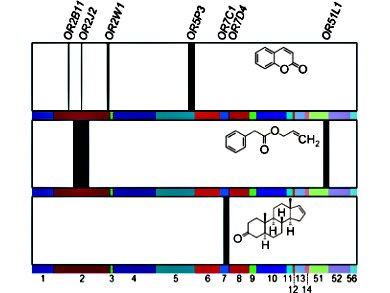Odor Code for Food Based on a Few Volatile Substances
The actual flavor of a food is experienced through our sense of smell rather than with our tongue. However, of the large number of volatile compounds in foods, only about 230 are involved in the scent, as reported by German scientists in the journal Angewandte Chemie. The different smells derive from characteristic combinations of three to forty of these odorants.
Olfactory Cells
When we eat or drink, volatile substances pass through our mouth to our roughly 30 million olfactory cells. Special receptors bind to the odor molecules, resulting in an electrical signal that is transmitted to the brain. When we smell a mixture of several chemical components, multiple types of olfactory cells are activated. The nerve cells in the brain then produce a specific activation pattern in the form of a topographical “scent map”.
Scanning Odorants
Thomas Hofmann and a team of scientists at the Technical University of Munich and the German Research Center for Food Chemistry, Leibniz Institute in Friesing-Weihenstephan, Germany, have systematically combed through, analyzed, and statistically evaluated the available literature on odorants. Their meta-analysis yielded an astonishing result: “Of the roughly 10,000 volatile compound that have so far been identified in foods, only about 230 act as genuine key odorants”, reports Hofmann, “and the typical scent of most if not all foods is produced by a characteristic ratio of only three to 40 of these compounds”. The scientists hypothesize that the natural odorant molecules in our food and our 400 or so odorant receptor proteins developed in concert through evolution.
The smell of a food is dependent on the right mixture of odorant molecules because combination results in entirely new smells. “For example, the combination of an odorant that smells of geraniums with one that smells of boiled potatoes generates the molecular basis for the fishy smell of boiled cod and sardines,” says Hofmann. “At a concentration ratio of 1:100, they lose their original odor character in favor of the fishy smell.”
Decoding Odorants and Olfactory Receptors
Decoding all of the relevant odorants and olfactory receptors opens up interesting new possibilities for the production of biomimetic odor mixtures that could be used to authentically reconstruct natural odor signatures for food flavorings, perfumes, or olfactory accompaniment in movies, as well as in biomedical applications like the regulation of appetite and satiation. Feelings of ravenous hunger could thus be suppressed with flavors that have the authentic odor profile of high-calorie foods. Knowing the odor code for crops and fruits could also be helpful in farming. Instead of breeding crops solely based on storage life – often at the cost of flavor – it should be possible to breed more flavorful varieties. Artificial noses based on biosensors could control food production or be useful in diagnostics.
- Nature’s Chemical Signatures in Human Olfaction: A Foodborne Perspective for Future Biotechnology,
Andreas Dunkel, Martin Steinhaus, Matthias Kotthoff, Bettina Nowak, Dietmar Krautwurst, Peter Schieberle, Thomas Hofmann,
Angew. Chem. Int. Ed. 2014.
DOI: 10.1002/anie.201309508




